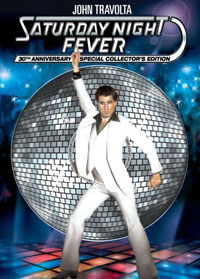Saturday Night Fever made disco style eternal cultural phenomenon
Saturday Night Fever – one of the most famous films ever made – hit the screens 30 years ago. The motion picture glorified one of the most mysterious phenomena of modern culture – disco.

Movie critics say that Saturday Night Fever precisely mirrored the unique cultural phenomenon which made almost the entire world worship disco music.
One of Russia’s most outstanding scientists of culture, an expert of world cinematography, Kirill Razlogov, said in an interview with Pravda.ru that Saturday Night Fever takes a special place in the American cinema. The film was a huge success, although it was not meant to become a piece of entertainment or a screen show.
Saturday Night Fever was made as a social drama. Its main character Tony Manero brilliantly portrayed by John Travolta feels that he can thoroughly enjoy life only at weekends when he goes to a local discotheque. On Saturday night he puts on a white suit and goes to the disco where he becomes “the king of the world.”
“The film captures the meaning of mass culture that gives everyone a chance to experience 15 minutes of fame,” Kirill Razlogov said.
Disco music and discotheques appeared in the beginning of the 1970s when the socially-oriented rebellion of the youth started to gradually disappear from the Western society. Hippie ideas, various psychedelic utopias affected presumably intellectuals but did not show much influence on common young people. Disco offered a completely different way of escaping from reality. Medics later concluded that disco music showed only positive influence on young people and their physical and emotional health.
The film became extremely popular all over the world. Its soundtrack written by Bee Gees topped music charts in the United States, Europe and Asia. John Travolta became an idol for hundreds of millions of people. The actor became a sex symbol of the whole Western world for several years. Young men wanted to copy Travolta in everything – his clothes, his dance skills and even his hair.
Travolta has had quite a number of ups and downs since then, but Saturday Night Fever still enjoys immense popularity. The collector’s edition DVD of the film was released in 2005 and sold almost three million copies.
It is worthy of note that the center of world disco moved from the United States to Europe after the global success of Saturday Night Fever. Pet Shop Boys, Bad boys Blue, Modern Talking, Blue System and many other artists produced quite a number of disco hits. Their commercial success was impressive, but their work did not became a major cultural event in the world, as it happened with Saturday Night Fever.
Disco became popular in the Soviet Union too, although the country was closed from the rest of the world during the communist regime back in those years. A group called Mirage appeared in the USSR in 1986 and became an outstanding sensation in the Soviet pop music. The songs of the group became a bright alternative to social and pseudo-philosophical rock music.
The music crisis that gripped mass culture during the recent decade eventually made the general public turn to the classic of disco. Pop icon Madonna, for example, made a triumphant return to music charts with her “Confessions on a Dance Floor” CD, which was entirely devoted to disco. The singer used the Queen of Disco image for the packaging of the CD, new videos and for the highly successful Confessions Tour, which became the top grossing tour for a female artist in history. For her hit single “Hung Up” Madonna used a sample of the song “Gimme Gimme Gimme” originally performed by iconic disco band ABBA. A combination of all these aspects earned very good money for Madonna and helped her recover after the flop of her previous album, American Life.
Specialists say that disco has become a cultural phenomenon for all generations. Disco is not only good for health. It contains absolutely healthy erotica, deprived of all decadence that can be seen in many music styles of recent times.
Irina Sarkisova
Pravda.ru
Translated by Dmitry Sudakov
Subscribe to Pravda.Ru Telegram channel, Facebook, RSS!




